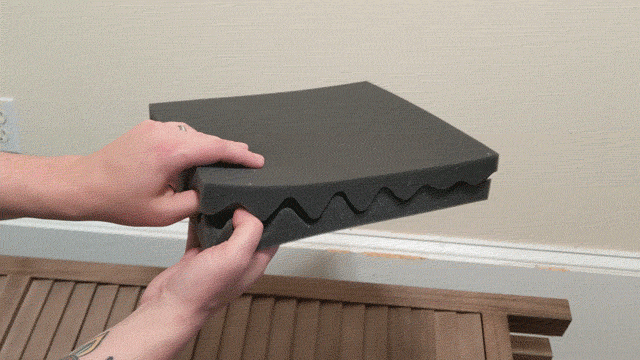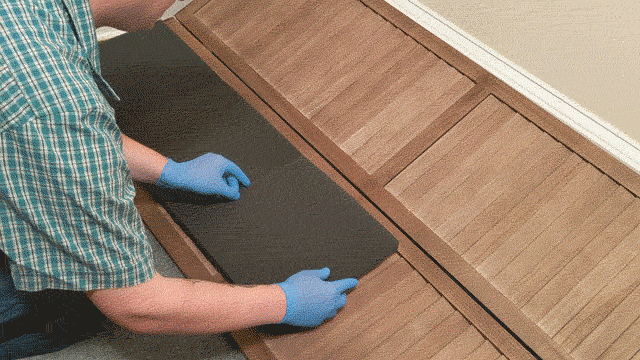
Goals
We want to create a recording booth with a minimum expense and making as few permanent modifications to the home as possible. We will do so by mounting acoustic dampening foam to one or more partitions, and creating a cover to sit on top of the assembly.
This recording booth will moderately reduce outside noise, and will "deaden" the sound within the booth itself. The end result of this work is that recordings made within the booth will have significantly reduced outside noise, vibrations, echo, reverb, and other unwanted noises to produce a much cleaner recording of your voice.
Using This Guide
While this guide is showing a specific build for a modular, near-professional recording booth, the ideas and pieces on the parts list can certainly be used to guide you in crafting your own recording space. You can take this guide as far as you like. Even minimal application of the ideas in this guide can have a substantial impact on your acoustic profile.
For example, you may only want to deaden specific items in your room, such as the fan noise from your computer. An acoustic tile could be mounted behind your computer tower to reduce the amount of noise that bleeds off of the back wall. Or you could create a "hood" that sits on your desk to go just around you and your microphone.
Parts List
Acoustic Treatments
Acoustic treatments attenuate sound within specific frequencies. These should not be confused with actual soundproofing, which is very expensive and best done during construction. The pieces listed here will provide sound reduction with a noise reduction coefficient (NRC) of about 0.5. NRC scales from 0 to 1, with 1 being "perfect absorbtion." While pricing out foam, be sure to check if the brand lists the NRC!
One thing to consider when purchasing foam is that more is more. The more densely you cover the walls and ceilings in your recording area, the better the sound absorbtion will be.
- 12 Piece Acoustic Foam - $19.95 x 8 = $159.60
- Adhesive Spray - $12.98
- Adhesive Strips - $14.88
The Wrap-Around
A room partition can be placed in a corner to create a small studio space. We will attach our accoustic foam directly to the partition. An obvious benefit of this approach is that it is modular and movable.
For example, if one were to construct a small partition booth in their guest room, that booth can easily be removed when company comes over. Furthermore, one could use multiple partitions to create a booth with no permanent adjustments to their house!
Most partitions are about 6' tall, but be sure to check the height while purchasing to make sure that you will have enough headroom to get in and out of your booth comfortably.
1) Partition - $139.99
The Cover
Rooms with low ceilings may only need to have a few pieces of acoustic foam attached directly above the recording area to effectively dampen echos and reverb. Rooms with high ceilings, however, will require something closer to the booth to work effectively. In this case, we will create a cover to sit atop our partition.
The cover does not need to be complex at all. A simple piece of thin, stiff board lined with acoustic foam will suffice. Once you have your booth partition set up, measure the space on top and have your local home improvement store cut you a piece of MDF, plywood, plexiglass, or other material of choice to fit. I also strongly recommend that you purchase some form of hinge, latch, or other way to attach the covering to the partition and/or your wall so that it will not fall on you!
Expected cost for this portion is ~$30.
Other Items
Once your booth is complete, you are going to need a few things to put inside of it. A rug is highly recommended if you have hardwood floors, the thicker the better. You will also want a chair and a small table or desk to put your laptop and microphone on. For the best results, drape a thick cloth like a comforter over the table and use a padded chair. You most likely have all of these things available to you, so I will not list items for this here.
Total Costs
Adding everything up, we come to a total of $357.45, not including tax ($497.44 if you are using two partitions). This is a very good price for what should provide near-studio quality recording in the home, especially considering that this whole project is rather portable.
Constructing Your Booth
Expand Your Foam!
The first thing you should do after receiving your materials is to unpack your foam. Most acoustic foam is heavily compressed before it ships, and can take up to 48 hours to fully expand. You should absolutely let your foam fully expand before working on it. You could face issues if you attempt to glue the foam before it finishes expanding!

Measure Twice...
Lay out the wrap-around as flat as you can and assess how your foam will fit on each panel. A single piece of foam will likely be too small to cover the entire panel, and two pieces of foam will likely be too large. You could cut the second piece of foam to fit the panel, but I opted for a different solution.
Lay out your foam in a contiguous line down the center of one panel. Now lay out another contiguous line down the adjacent panel. Measure the distance between the pieces of foam. Cut excess pieces of foam into strips roughly matching the width of the gap. You do not have to be extremely precise here, as the foam will compress when you set up the booth.

...Glue Once
Now that you have your placement strategy ready, prepare to glue the pieces down. You will be best-served to focus on one panel at a time, so go ahead and remove all but one strip of foam from the wrap-around. Flip that strip so the spikey side is face down and the whole row is out of the way, but close enough to work on.

Check the instructions on the spray adhesive that you purchased for this project. Most spray adhesive, including the adhesive recommended in the parts list, will recommend spraying both objects that will be glued together. Furthermore, I personally recommend wearing disposable gloves and spraying in a well-ventilated area.
When ready, spray both the line of foam and the area that they will attach to. Wait for 1-2 minutes (or as recommended by your adhesive spray directions), then carefully line up and attach each piece of foam. Repeat this process for each panel along one side of the wrap-around. There is no reason to cover both sides!


Permanent vs Temporary Gap Strips
You will need to make a decision now. Do you want to permanently glue the gap strips in place, or do you want to pressure-fit them in each time you set up the booth? While the option to glue seems obvious, please be warned that permanently gluing in the strips will eliminate your ability to fold down the fully-assembled wrap-around. If you want to keep the option to somewhat compress the wrap-around during storage, then do not glue the strips in place. Yes, this will make the whole assembly more time-consuming to set up, and you will have to store the strips separately, but this is a concession you may want to make for a more flexible storing strategy.
If you do decide to glue them in place like I did, then follow the same gluing instructions above, but make sure to only apply glue to half of each strip. You do not want to attach them to both of the panels that they are bridging! If one side is not floating, you will have a significantly harder time getting the wrap-around to curve.

Attaching Foam to the Wall
Unless you have purchased two wrap-arounds, you will be using a wall or a corner as part of the booth siding. We will want to dampen acoustic reflection here as well, but we absolutely do not want to use adhesive spray! The spray will permanently mark the wall, and would require scraping and repainting to remove.
Instead, we will use double-sided foam tape. This tape can be light-duty, as acoustic foam is typically very lightweight. Simply attach a quarter-sized piece of foam tape in each corner of each acoustic tile, then line it up in a grid along your wall. You do not need to go overboard here, however! You would receive little to no benefit covering areas like the baseboard or under/behind your desk. Realistically, you only need to worry about areas that you can see from your recording position.
An alternative strategy for your walls would be to purchase sheets of wood matching the area you need to dampen, then permanently fixing the foam to that wood. You could then hang that piece of wood like a picture frame when setting up your space, and store the whole panel when not in use.
Constructing the Cover
Now that all of your horizontal space is deadened, it is time to create a cover to reduce upward reflection. This pièce de résistance will prevent you from capturing reverb, and will significantly tighten up your vocal presence.
I cannot offer too much guidance here, as veritcal spaces will have more variation than horizontal spaces. I can, however, provide the example that I am using.
I purchased a piece of MDF from my local big-box home improvement store, along with hinges and two angle braces. My booth is in a corner, so I attached the longest side of the MDF to the wall via the hinges about an inch above the height of the wrap-around. I then attached the two angle braces to the adjacent wall at the same height. The whole cover folds down and rests on the angle braces, but can back fold up to the wall when not in use.
Stay Tuned!
While this guide provides the specific build that I am using, you can easily modify these plans to suit your needs. If you use this guide, I would love to know what worked well for you and what you may have improved upon! Please send questions, comments, and suggestions for improvement to @drewofdoom.
And stay tuned! The biggest modification I am working on for this project right now is a way to pipe in cold air without affecting the sound quality. I will report back once I have a solution.
